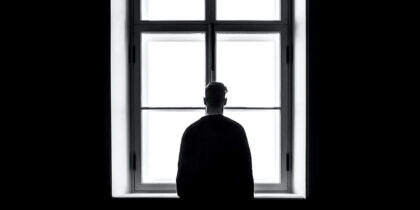30th September 2022
By Dr Amy Pollard @AmyRPollard
Sign up to Amy’s mailing list to get updates on her writing.
Listen to the piece:
Writer in residence: “From banishment to coming together”
Introduction
Phew! So we’ve reached the final piece in my Writer in Residence series, and what an adventure it has been.
I used to think that mental health difficulties were just tough times to get through. I thought that periods of ill-health were times of suffering – times when I was not myself – defined by my inability to do normal things and hold myself together. In the best-case scenario, I thought that such personal struggles were an opportunity to develop more empathy, learn about myself and come back stronger – humbled, but with better skills for looking after myself and others.
The process of writing the series has got me thinking that whilst this is not exactly untrue, it’s not the whole truth either. We can indeed be humbled by periods of mental ill-health, but the Latin root for humble is ‘humus’ – meaning of the earth. Just as a leaf falls from a tree and breaks down into the components of soil, the process of psychologically falling apart can break open the components for growing something new. This can be about growing individually, and sometimes it can also be about growing as a society – coming together in new ways and making connections that we hadn’t made before. Recovering from mental ill-health isn’t always about getting ‘back to normal’ – it can also be about looking at the norms and values of our society in a new light. And it can mean living out a change in them.
In this final piece, I’d like to pull the writing series together. I’ll recap the argument that I’ve been building and consider how it contributes to the social and political challenges we collectively face in the 21st Century. I’ll reflect on how, three centuries on, there may be a shift in the dynamics that resulted in the banishment of people with mental illness in the 17th and 18th Centuries. As the Enlightenment’s Age of Reason is disrupted by the Information Age, relationships between the external world and our inner lives are changing. The tools for navigating psychological crisis can guide us through this territory – not so much because they are new, but because they’ve been there with us all along.
Recap
In my first piece, “Banished”, I explored the roots of loneliness in mental ill-health.
I described the six broad principles which underscored Enlightenment thinking, and how the most dominant of these, “Reason”, meant that non-reason was banished to the cultural wilderness. Through a historically contingent process which accelerated from the 17th and 18th centuries, people with mental health difficulties found themselves out in the wilderness too. We use the term ‘madness’ both to talk about mental illness and also to refer to illogical or irrational behaviour. Where modern society has been forged through ‘The Age of Reason’, those who are considered non-reasonable – the mad – have no place within it. As part of a process which bolstered the norms and values of mainstream society, the unwell were scapegoated; sacrificed to the cause of purifying Enlightenment culture and forging boundaries from within which the well could drink.
In the second piece, “Anchors Away”, I drew on my ethnographic training and personal experience of bipolar to consider whether people with mental illness had been banished in error. I described what was it was like to watch Match of the Day in a hypomanic state and considered the extent to which psychotic beliefs are, in fact, reasonable misunderstandings of stuff that is always going on in our lives. I described how we can use techniques from dream analysis to make sense of psychosis – considering it as a reflection of our inner lives which deserves to be taken seriously, not literally.
I argued that we should listen to psychotic experiences with more open-mindedness and imagination, and that we should expect to find some mystery. If we don’t “get” what’s going on, it doesn’t need to be a big deal. What matters is treating people as human beings, and if this is your goal then asking “does this make sense?” is asking the wrong question. There’s more to being human than that.
The third piece, “Graceful Resolve”, looked at practical and tangible ways of navigating extreme psychological distress. Over the years, I’ve gradually become better at ‘swimming’ in the choppy waters of bipolar, rather than drowning in them. I unpacked four attitudes I personally find useful: playfulness, acceptance, compassion and curiosity. Playfulness can de-escalate the anxiety vortex that often sweeps people into crisis, and create a sense of greater possibility and connection. Acceptance is at the heart of much spiritual teaching, and can help us humbly recognise what we’re going through as human beings. Compassion must be the bedrock – both for the ways we care for ourselves, and for others caring for us – especially when we become so unwell that we’re not conventionally understandable. Finally, curiosity (which comes from the Latin cura, ‘to care’) is the difference between caring for someone and doing things to them.
To have hope isn’t necessarily to be optimistic that things will turn out well; it’s knowing that things will be meaningful however they turn out. Curiosity is crucial because whenever we get curious about what something means, we recognise that hope – in this sense – could never not be there.
In the fourth piece, “Has the world gone mad?”, I applied these lessons from navigating psychological crisis to a wider context. I compared the polarisation and breakdown that we’ve seen at societal level in recent years with the individual-level breakdown of bipolar. Whilst the contexts are very different, I argued that there are parallels between these two forms of polarity – especially when you step back from the detail to look across the big themes.
My argument was that some of the skills and insights that people develop in the context of individual ‘madness’ can contribute to our collective efforts to navigate ‘mad times’ of polarisation and societal breakdown in the 21st century. ‘Mad skills’ like playfulness, acceptance, compassion and curiosity can help us roll with the punches when we’re dealing with difficult things as a society – and have specific applications in the context of political polarisation. I’m not saying that people with mental health difficulties hold the keys to solve everyone’s problems, or that our insight is somehow more special than everyone else’s (like giving birth, it is both banal and special at the same time). People with mental health difficulties can, however, embody that life isn’t always about moving forward, and that if things aren’t going perfectly it doesn’t mean we’re irredeemably broken or damaged. As we face the ‘mad times’ of the 21st century together, it’s no bad thing to have contributions from people with mental ill-health in the mix.
The fifth piece, “The Witch and the Curator”, was a fairy story about a friendship between a witch and the Curator of the British Library. It explored the symbolism of the colours ‘black’ and ‘white’ – two colours that are commonly used for depicting polar opposites. The black/white colour palette is frequently used to represent contrasting moods in bipolar, and has been overlaid with heavy cultural significance. They are keystone colours in a mental health context, and in western confrontations with death. They are used to image a contrast between the conscious and the unconscious, in Enlightenment imagery (where the ‘light of reason’ was to triumph over the ‘dark ages’) and, of course, as the leitmotif of structural racism.
I explored how bringing a symbolic lens to these contexts might enable us to make connections and unlock energy for anti-racist ally-ship in a different way. I suggested that a ‘call out’ approach to anti-racism might be complimented by an additional attitude – where we build a relationship with our unconscious rather than laying bear and judging it. As the anthropologist Roy Wagner explored, a true symbol can never fit into our field of vision. [1] There’s a sense in which you have to not know the full story about what’s going on in order to feel moved emotionally – and you can’t create a genuine social movement that doesn’t move people. Accepting that human beings are not designed to be fully conscious of everything, I suggested that making an ally of our unconscious might support a shift from hollow and empty gestures towards meaningful change.
What it’s all been about
That’s all you need to do to relate to someone in psychological crisis: Look, listen and feel. Respond in turn. If you don’t know how to respond, just breathe. That’s a response too.
Richer experiments
Babies are always doing experiments. As they look, listen and feel, they find out what the funny old business of being alive is about. It takes an experiment for a baby to learn the difference between themselves and the world around them. They kick their little legs and feel the edges of their cot, and the resistance of these boundaries lets them know where their gorgeous chunky bodies stop.
In adult life, we tend to take for granted that ‘everyone knows’ the difference between their inner lives and the external world. But as the Age of Reason is disrupted by the Information Age, these assumptions are no longer on totally solid ground. The algorithms that mediate our digital lives are self-referential – that is, they filter information from the world in a different way for each of us, depending on the choices we’ve made previously. The information that comes to us through our unique algorithmic prisms not only reflects the external world ‘out there’, but also what tech companies can deduce about us through big data. The external world is mediated by our inner lives not only through our subjective interpretations, but in a practical, concrete way. It literally changes what we see in front of us – and makes the line between our inner lives and the outer world more fuzzy and harder to delineate.
On one level, you could read this simply as a faster, more intense version of the challenge human beings have always had to understand how compound choices shape our lives. But for me, the speed and intensity of the Information Age means that this is more than just pressing on the accelerator a bit. The speed and intensity of your mind when you’re hypomanic is a noticeably distinctive thing for people with bipolar, and arguably the information overload that we’re dealing with in the 21st century makes figuring out what’s going on in the world a genuinely different task today.
We’re finding ourselves in a context where the traditional Enlightenment model for experimentation can fall somewhat flat. It is not always effective to look at the same thing from different perspectives, figure out what’s true and what’s false, and then point this out in order to establish a collective sense of reality – certainly not in the time that is available before prevailing views are formed these days. Ironically, in our polarised political landscape, this approach can actually drive people towards more divergent positions. There’s so much information flying around – so many different reference points – that it’s often not possible to integrate it piece-by-piece and build a shared understanding of what’s ‘true’ together before an untrue view of reality has already flown the coop. The volume of information feels so threatening that people go into a ‘fight or flight’ mode – abandoning the effort to establish a shared reality, or battling others to the death through ad hominem attacks.
I would propose a richer model for experimentation in the 21st century, where we not only test ideas externally, but in terms of our internal reference points too. The challenge of dealing with stuff that comes up in our inner lives is that it can’t be checked or verified by external sources – nobody else can authoritatively decode which part of your psyche is prompting you to react to something in a particular way, or tell you definitively ‘what is going on’ in your own head. But just because something isn’t material (available to be looked at by others), that doesn’t mean it’s not important. What comes up in our minds doesn’t have to be fully logical in order to be meaningful – especially if we take it symbolically, not literally.
We can gradually build a map of our psyches ourselves – noticing the thoughts, images and feelings that come up and looking for patterns, and slowing down before we make assumptions. We can take an ethnographic approach to our inner lives – observing, taking notes and understanding it iteratively. The things that seem so very wrong in the world ‘out there’ may also relate to the parts of ourselves that we think are wrong and don’t want to know about. By getting curious and testing for resistance we can – like the baby in the crib – get better at discerning the boundary between our inner and outer lives. Knowing your internal reference points enables you to “check in with yourself” – to develop a mode of scrutiny which is anchored in your integrity, rather than only in the external reference points that other people share. Crucially, this is quicker than reading the whole internet to figure out what’s going on – and it can give you a way of connecting with others that can weather the gaps in our understanding.
Integrity is about being whole. It’s about being in three dimensions, where you can be seen from all angles and still be the same person. It’s not about striving for perfection – indeed, being in three dimensions always means having a shadow side. This way of experimenting is rich precisely because it accepts the shittiness of human beings and values them in a different way.
Coming together
When non-reason was banished by the Enlightenment, it didn’t go far. The parts of human beings that are illogical, irrational and unfathomable have always been there – projected onto those of us who manage mental illness, but core dimensions of everyone who is alive. These come up through our dreams, our instincts, our intuition and our bodies – available to anyone who cares to pay attention.
Cultures are fluid, and I don’t think the banishment will last forever. I suspect that as the Information Age advances, there will have to be a reckoning with the Age of Reason principles which have governed the relationship between knowledge and power over the last three hundred years or so. Automation, inequality and ecological collapse will unsettle norms and values about the purpose of our lives, and trigger an existential crisis about what it means to be human.
Not for the first time, these societal struggles will be imaged through debates about female and male bodies, and projected onto people who are represented as ‘black’ and ‘white’ polarities in mainstream culture. A digital age of zeros and ones lends itself to the symbolism of opposites. There will be a lot of anger and heat – like inflammation around a wound, this will serve to alarm and protect. The anger indicates a need for healing, but must not be mistaken for the wound itself. I’m not sure what paradigm we’ll grab onto next, but I suspect we will let go of the idea that reason is the defining characteristic of humanity. We’ll want something kinder, I expect.
It’s petrifying in some ways. Scary, but also petrifying in the geological sense of revealing the minerals that were in our cultural waters all along. Banishing people doesn’t get rid of them, and people with mental illness have been quietly shaping the social landscape – acknowledged or not – simply through our survival. When water is pushed away, it carves out the land beneath it. In dark caves, the drip, drip, drip of water forms stalagmites and stalactites. People with mental ill-health have shaped the landscape of society, not only through campaigning and talking about their experiences, but also just by putting one foot in front of the other every day. Even if you’re so poorly that you can barely manage the washing up, you’re still playing an important part in the world. Simply by surviving, you’re living out a different way of living – demonstrating that it can be done. For my money, living this way is all the more honourable for being challenging.
It sometimes feels possible to glimpse a different way of framing our times, which enfolds non-reason, rather than pushing it away. My name for this is the Contemporary Renaissance. I say contemporary because it’s about what’s going on in the now – being alive to the present moment and the meaning that is being constellated, however fleetingly, right now. I say renaissance because it’s about bringing different things together in times of trouble, so that you can come back to ordinary life or bring something new into the world – a personal process and a contribution to society too.
The dynamics of renaissance are not novel – like the image in a magic eye picture, they were always there, but you have to shift your focus to see them. They emerge in moments when our heads, hearts and guts come together – and when something unknowable is alongside us, too. Sometimes this might be frightening and sometimes it might be a comfort. In my experience, it’s helpful to think of yourself as a channel (rather than a source) for such transcendent energies; and appreciate how they are different than you.
For me, the feeling of being accompanied by something unknowable waxes and wanes, and I’m not sure whether this is ‘just me’ or something bigger than me (like God). It could be either, or both, or these might be one and the same – the ‘Self with a capital S’, as Jung would say. But the questions I have about the nature of transcendent forces are secondary to the call to respect them. Doing so is to trust that difficult times can be navigated not so much because of your willpower, but because of the power in you that goes beyond your will: that is to say, the power of love.
I used to think that the most challenging part of having mental health difficulties was the loneliness. Indeed, a sense of connection to someone in distress – demonstrated through our actions, our words and our imaginations – might be the greatest gift we can offer them.
The biggest challenge, however, is not being alone. It’s trusting that we’re not.
Appendix: A soundtrack for social and psychological crisis
Mysterious Girl, Peter Andre
He’s underrated as a philosopher, but Peter Andre’s 1996 pop-reggae classic is perhaps the ultimate non-reason anthem. What on earth is going on in that video?! Are we in the Caribbean? Are we in Thailand? Why is he wearing trousers in the sea? Who does yoga in a waterfall?! I love this song because it’s a perfect example of why, sometimes, trying to get to the bottom of what’s going on is missing the point entirely. It’s an ideal song to turn to if you are worried about not being understandable and need to see the bigger picture.
Desperado, The Eagles
With its opening line, “why don’t you come to your senses”, Desperado is a useful track for times when your mind is racing away and you need to connect with your body. Originally written as an Americana song about outlaws, it works well as a meditation on psychological crisis and the early stages of psychosis. It evokes the confusion that can creep in when you’ve been out “ridin’ fences” for a long time, the sensory distortions of sleep deprivation, and makes practical suggestions about allowing others to help.
Welcome to the 60s, Hairspray
This big dance number from the 2002 musical is about a woman being coaxed out of self-imposed confinement by her daughter, who persuades her that 1960s society has changed and will now accept her. It’s a song about how personal and societal transformation interweave, made all the more poignant for being sung 40 years after the ‘new age’ of the 1960s supposedly dawned. This mismatch of timelines affectionately punctures the hubris of grand historical proclamations, without downplaying their significance for individuals.
Many Rivers to Cross, Jimmy Cliff
Jamaican singer Jimmy Cliff wrote this song of exhausted despair and desperation in 1969, when he was 21 and struggling to catch a break as a musician in England. Its lyrics speak of a long and painful journey with no end in sight. In 2008, Cliff gave a masterful performance of the song on Later with Jules Holland, dressed head to toe in red. He included an improv section where he added the Islamic prayer: “love, love is my foundation; wisdom is my capital; struggle is my manner; truth is my redeemer; sorrow is my companion; love is my foundation.”
[1] Wagner, R (1986) Symbols That Stand for Themselves. University of Chicago Press.






